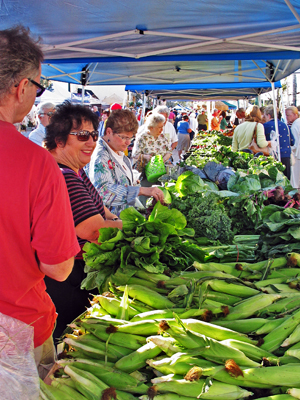The older (or should I say more mature) I get, the more interest I have in environmental issues. Since moving to Sarasota I’ve become a fan of the Saturday morning Downtown Farmer’s Market, where local organic and traditional farmers sell fresh-picked fruits and vegetables. Not only does everything that I buy here taste delicious, it lasts longer, because it hasn’t been on a truck for three days, crossing the country. The last bag of spinach I bought at the Farmer’s Market was from Worden Organic Farms and it lasted a full three weeks without a hint of slime appearing. Can you imagine that happening with a store-bought bag of spinach?

There’s so much to be said for buying local products. It supports the area farmers; it makes available fruits and vegetables that were picked at the peak of ripeness, rather than just before their prime; and it cuts way down on the carbon footprint, since it does not necessitate a fleet of trucks burning precious diesel to cart it across the continent. I don’t think anyone would argue with this reasoning. It’s simple and it makes sense.
Unfortunately, as I recently learned from an article in the New York Times, our Federal government works forcefully and deliberately to ensure the local food movement doesn’t expand. Jack Hedin is a small organic vegetable producer in southern Minnesota who regularly sells his produce at a local Farmer’s Market. The Market has become so popular that he knew his 100 acres would not be large enough to meet demand, so last year he rented 25 additional acres on two nearby corn farms. He plowed under the alfalfa hay that was established there and planted watermelons, tomatoes and vegetables.
All went well until early July. That’s when the two landowners discovered that there was a problem with the local office of the Farm Service Administration, the Agriculture Department branch that runs the commodity farm program. The commodity farm program effectively forbids farmers who usually grow corn or the other four federally subsidized commodity crops (soybeans, rice, wheat and cotton) from trying fruit and vegetables. Because Hedin’s watermelons and tomatoes had been planted on “corn base” acres, his landlords were out of compliance with the commodity program. Not only did his landlords lose their subsidies for the year on that acreage, they had also risked making those acres ineligible for any future subsidies, not to mentioned being penalized the market value of the produce, $8,771.
The federal farm program is making it next to impossible for local farmers to rent land to grow fresh organic vegetables. Why? Because large corporate national fruit and vegetable growers fear competition from regional producers. Through their control of Congressional delegations, they have been able to virtually monopolize the country’s fresh produce markets.
Just how does this make sense? And when did our government get so far off-beam? Farmers need the choice of what to plant on their farms and consumers need more farms producing high-quality fresh fruits and vegetables to meet increasing demand from local markets without the Federal government actively discouraging them.
